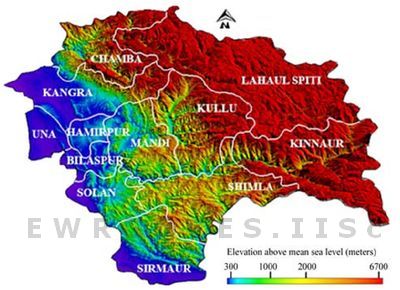|
Study area
1. Landscape and climate
Himachal Pradesh is located between 30.38°–33.21° North latitudes and 75.77°–79.07° East longitudes, covering a geographical area of 55673 km2 with 12 districts (Statistical Data, Himachal Pradesh 2009–10). It has a complex terrain with elevation ranging from ~300 to 6700m as shown by the Digital Elevation Model (DEM) in Figure1. Topography, climate, soil and vegetation clearly define the agro–climatic zones in the state. Parts of Una, Bilaspur, Hamirpur, Kangra, Solan and Sirmaur districts lower than 1000m above mean sea level represent the tropical zone. Certain segments of Solan, Sirmaur, Mandi, Chamba and Shimla districts located between 1000–3500m have climate conditions varying from sub–tropical to wet–temperate. Lahaul Spiti, Kullu, Kinnaur and some parts of Shimla districts ranging between 3500–6700m are part of the high elevation dry temperate, sub–alpine and alpine zones with sparse vegetation and rainfall.

Figure1: Digital Elevation Model (DEM) of Himachal Pradesh
2. Energy and environment
The hill state of Himachal Pradesh represents one of the rich biodiversity zones adversely impacted by unplanned development. Field investigations reveal substantially high energy requirement due to the colder climatic conditions, particularly in high elevation zone (>3500 m). People are largely dependent on forests (fuelwood) for meeting their heating (room and water) and cooking demands, although vegetation cover is sparse in high elevation zone (Ramachandra et al., 2012). This has resulted in decline of vegetation cover, fragmentation of forests and associated ecological imbalance in an ecologically fragile region such as the Himalayas.In recent times, there has been increasein fossil–fuel based energy consumption,with resultant pollution and glacial melting (Aggarwal and Chandel, 2010). This necessitates exploration ofclean renewable energy as decentralisedsources. Even so, marginality and negligence of these mountain regionsin the past have led to scarcity of reliable data which hinders efficient resource assessment and planning(Bhagat et al., 2006).
|


